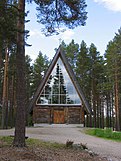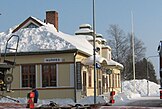North Karelia
North Karelia
Pohjois-Karjala Norra Karelen | |
|---|---|
 North Karelia on a map of Finland | |
| Country | Finland |
| Historical province | Karelia |
| Area | |
| • Total | 21,584.41 km2 (8,333.79 sq mi) |
| Population (2009) | |
| • Total | 166,500 |
| • Density | 7.7/km2 (20/sq mi) |
| NUTS | 133 |
| Regional bird | Cuckoo |
| Regional fish | Lake salmon |
| Regional flower | Prickly rose |
| Website | pohjois-karjala.fi |
North Karelia (Finnish: Pohjois-Karjala; Swedish: Norra Karelen) is a region in eastern Finland. It borders to the regions of Kainuu, Northern Savonia, Southern Savonia, South Karelia and to Russia.
The city of Joensuu is the capital of North Karelia.
North Karelia is renowned among public health officials.[1] In the 1960s Finland led industrialized nations in heart disease mortality rates. North Karelia had Finland's highest incidence. In 1972 a long-term project was undertaken which targeted this risk in North Karelia.[2] The resulting improvement in public health is still considered remarkable, a model for the rest of the nation.[3]
Historical province
For history, geography and culture see: Karelia
Municipalities
North Karelia is divided into 13 municipalities.
- Ilomantsi
- Joensuu
- Juuka
- Kitee
- Kontiolahti
- Lieksa
- Liperi
- Nurmes
- Outokumpu
- Polvijärvi
- Rääkkylä
- Tohmajärvi
- Valtimo
Heraldry
The coat of arms of North Karelia is composed of the arms of Karelia.
Education
Institutions of higher education in North Karelia include:
both in Joensuu.
Politics
Results of the Finnish parliamentary election, 2011 in North Karelia:
- Social Democratic Party 26.4%
- Centre Party 26.2%
- True Finns 23.1%
- National Coalition Party 10.5%
- Green League 5.4%
- Left Alliance 4.2%
- Christian Democrats 2.8%
Gallery
-
Ilomantsi Orthodox Church; North Karelia has percentagely most Orthodox Christians in Finland
-
Joensuu Town Hall
-
Lake Pielinen as seen from Koli; one of the most acknowledged landscapes in Finland
-
Patvinsuo National Park, Lieksa
-
The Border-Karelian Bomba House, Nurmes
-
Paateri Church, Lieksa
-
Lake Kuorinka, Liperi
-
The old copper mine in Outokumpu, a town that was built around the mine industry
-
Lake Neitijärvi in Lieksa; forested hills and lakes between them are characteristic of North Karelia
-
Joensuu Market Place, the urban centre of the region
-
Buildings of University of Joensuu
-
River Pielisjoki and Major Pielisjoki, Joensuu
-
Nurmes Evangelic-Lutheran Church
-
The modern Evangelic-Lutheran church in Lieksa
-
River Lieksanjoki, Lieksa
-
Juuka Evangelic-Lutheran Church
-
Lake Pyhäselkä, Joensuu
-
Finnish Forest Research Institute in Joensuu; an example of modern wooden architecture
-
Railway station in Nurmes; an example of Jugendstil
-
A road in Lieksa
-
Joensuu Evangelic-Lutheran Church
-
The easternmost place in the European Union, Ilomantsi
-
Old preserved wooden houses in Joensuu
-
Rural landscape in Valtimo
-
Viinijärvi Orthodox Church, Liperi
References
- ^ "The North Karelia Project: 30 years successfully preventing chronic diseases" (PDF). International Diabetes Federation.
- ^ "Change in risk factors for coronary heart disease during 10 years of a community intervention programme (North Karelia project)" (PDF).
After the second world war cardiovascular diseases, predominantly coronary heart disease, became the leading public health problem in most of the industrialised world. Mortality statistics and other studies showed that in the 1960s the highest heart disease mortality rates were observed in Finland, predominantly in men. Within Finland the highest rates were registered in eastern Finland and were particularly high in the county of North Karelia.
- ^ "THE NORTH KARELIA PROJECT: FROM NORTH KARELIA TO NATIONAL ACTION". National Institute for Health and Welfare (Finland) [1].
In first five years of the North Karelia Project, for example, most of the reduction in cigarette smoking took place in the first year of the programme; most hypertensive individuals who brought their blood pressure under control achieved this by the end of the third year; dietary changes took place gradually over a five-year period; and, as noted earlier, at the end of five years, a net reduction in risk-factor levels was observed. Concerning mortality, CHD incidence and mortality rates started to decline surprisingly quickly after the start of the intervention in North Karelia. In the rest of the country, a similar decline started several years later. Thus a significant net change in favour of North Karelia was observed, especially in 1974 to 1979 (Salonen et al, 1983). Thereafter, although the decline in North Karelia continued, the net decline was gradually reduced. Thus maximal difference in favour of the intervention area was observed some 5-8 years after its start (Puska et al, 1995). For cancer mortality, a net reduction in favour of North Karelia could be observed much later, i.e., 5 to10 years after the intervention commenced.
{{cite web}}: External link in|publisher=|quote=at position 86 (help)



























